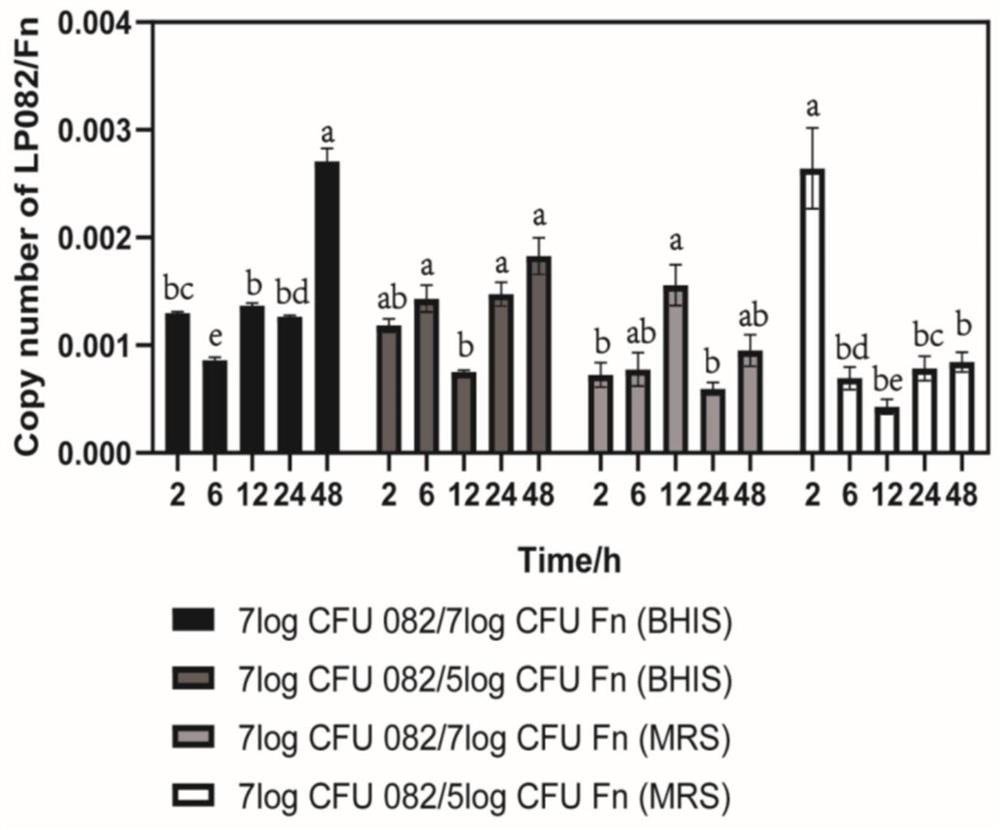Lactiplantibacillus plantarum HNU082 with antagonistic effect and application thereof
A technology of HNU082 and Lactobacillus plantarum, applied in the field of microorganisms, can solve the problems of destroying normal intestinal flora colonization resistance, intestinal flora damage, aggravating inflammation, etc., to enhance the intestinal and systemic immune response, and better antagonism Function, effect of increasing content
- Summary
- Abstract
- Description
- Claims
- Application Information
AI Technical Summary
Problems solved by technology
Method used
Image
Examples
Embodiment 1
[0033] Example 1 Screening and Identification of Lactobacillus plantarum HNU082
[0034] Preliminary screening: from farmers’ markets in different regions of Hainan Province, China (including eastern regions: Wanning, Wenchang, Qionghai, Lingshui; western regions: Lingao, Dongfang, Changjiang, Baisha; middle regions: Qiongzhong, Wuzhishan) Collect 36 parts of fermented vegetable samples, accurately weigh 10g fermented vegetable juice and mix in 90mL sterile NaCl solution (0.85%, W / V), and prepare a gradient of 10 by 10-fold dilution method. -1 -10 -5 sample diluent, take 10 -3 、10 -4 、10 -5 100 μL of concentration gradient dilutions were spread on MRS agar medium respectively, anaerobically cultured at 37°C for 48 hours, and 29 strains for primary screening were obtained after repeated isolation and purification.
[0035] Re-screening: Test the acid resistance and bile salt resistance of the above 29 primary screened strains, and further screen out the strains with strong ...
Embodiment 2
[0051] Example 2 In vitro antagonism experiment of Lactobacillus plantarum HNU082 on Fusobacterium nucleatum
[0052] In order to study the antagonism of Lactobacillus plantarum HNU082 and Fusobacterium nucleatum in vitro, the above two strains were inoculated into BHIS liquid medium (MRS liquid medium), co-cultivated at 37 ° C, 150 rpm / min, and at different times Point (2h, 6h, 12h, 24h, 48h) to extract DNA, using real-time fluorescence quantitative polymerase chain reaction (quantitative real-time Polymerase Chain Reaction, qPCR) method to obtain the abundance of F. nucleatum and L. plantarum HNU082. The experiment was divided into 4 groups, and the specific information is shown in Table 3:
[0053] Table 3 Experimental Grouping Situation
[0054] project Grouping First group BHIS+10 7 CFU / mL L. plantarum HNU082+10 7 CFU / mL F.nucleatum
Second Group BHIS+10 7 CFU / mL L. plantarum HNU082+10 5 CFU / mL F.nucleatum
The third group MRS+10...
Embodiment 3
[0065] Example 3 Lactobacillus plantarum HNU082 antagonizes Fusobacterium nucleatum in vivo animal experiment
[0066] Twenty-four 4-week-old C57BL / 6J male mice were taken. After 14 days of normal feeding and adaptation, the mice were randomly divided into 3 groups. The specific groups are shown in Table 4. There were 8 mice in each group, and the daily gavage volume of each group was 300 μL; all mice were intervened for 6 weeks, and on the last day, the mice were euthanized after fasting for 24 hours, and then the blood was collected from the eyeball, and the colon and rectum were collected. operate.
[0067] Table 4 Grouping of experimental mice
[0068]
[0069] 3.1 Antagonism test of Lactobacillus plantarum HNU082 on Fusobacterium nucleatum in mice
[0070] Take the intestinal contents of the mice in each experimental group, part of which is used for the test of antagonism, and the other part is used for the test of short-chain fatty acids. Specifically, adopt the me...
PUM
 Login to View More
Login to View More Abstract
Description
Claims
Application Information
 Login to View More
Login to View More - R&D
- Intellectual Property
- Life Sciences
- Materials
- Tech Scout
- Unparalleled Data Quality
- Higher Quality Content
- 60% Fewer Hallucinations
Browse by: Latest US Patents, China's latest patents, Technical Efficacy Thesaurus, Application Domain, Technology Topic, Popular Technical Reports.
© 2025 PatSnap. All rights reserved.Legal|Privacy policy|Modern Slavery Act Transparency Statement|Sitemap|About US| Contact US: help@patsnap.com



